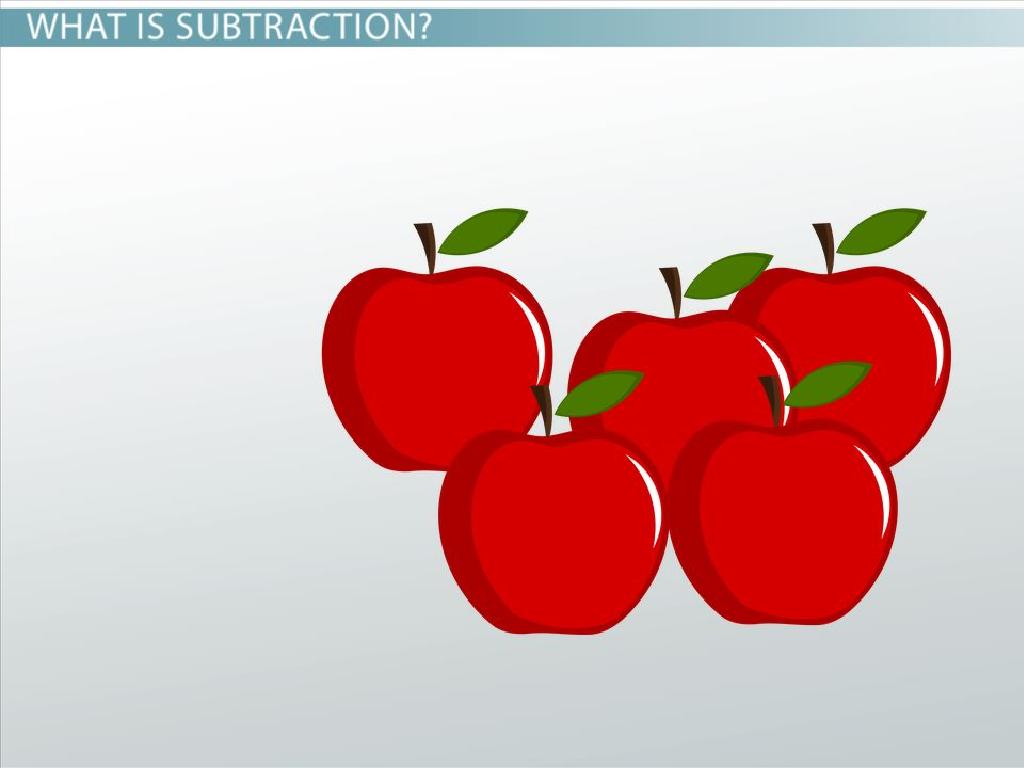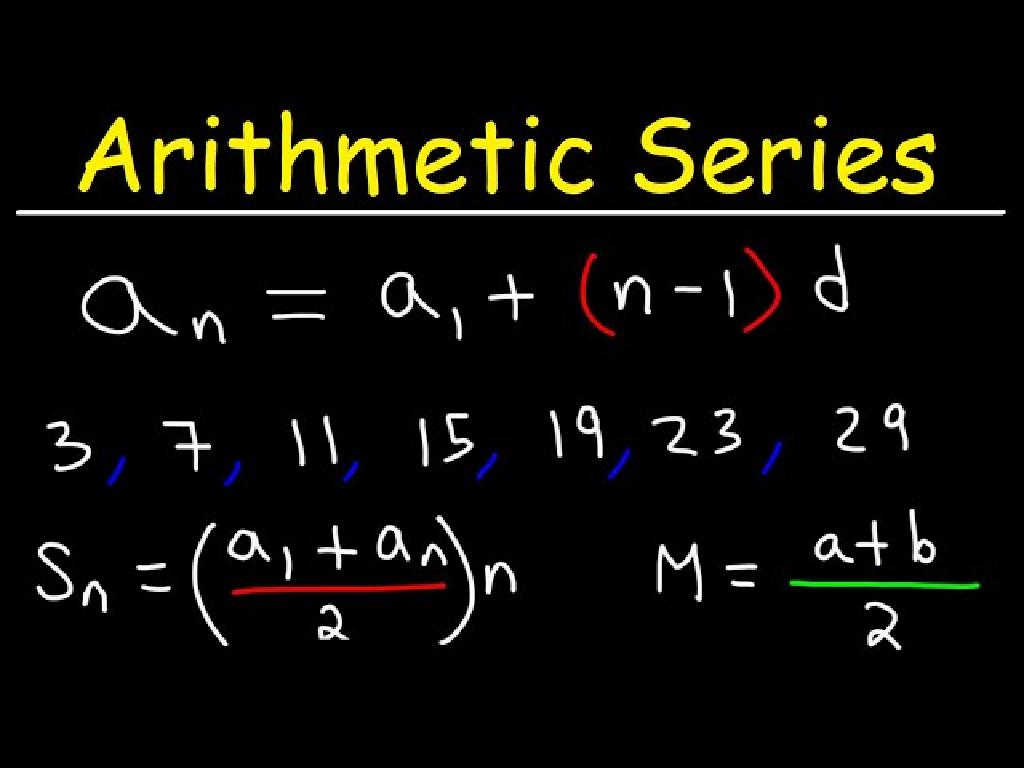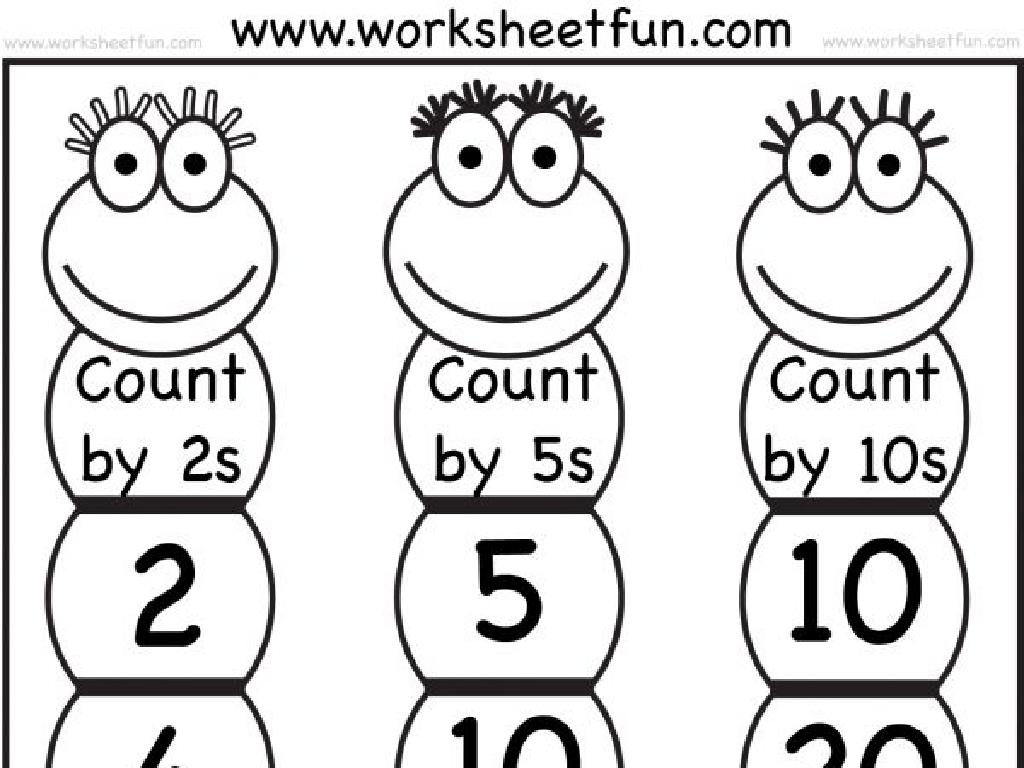Graph Fractions As Decimals On Number Lines
Subject: Math
Grade: Fourth grade
Topic: Relate Fractions And Decimals
Please LOG IN to download the presentation. Access is available to registered users only.
View More Content
Graphing Fractions and Decimals on Number Lines
– Understand fractions and decimals
– Fractions show parts of a whole; decimals show parts of one.
– Differences and similarities
– Both represent numbers between whole numbers; use different symbols.
– Today’s goal: graphing on number lines
– Convert fractions to decimals, then plot on a number line.
– Practice with examples
– Example: 1/2 is 0.5 on a number line; let’s find where 3/4 goes.
|
This slide introduces the concept of representing fractions and decimals on a number line, a key skill in understanding the relationship between these two forms of numbers. Start by explaining that fractions are another way to represent numbers that are not whole, just like decimals. Highlight that while they may look different, they can represent the same value and can be converted from one form to another. The goal for today’s lesson is to practice converting fractions to decimals and then graphing them on a number line. Provide several examples, starting with simple fractions like 1/2 and progressing to more complex ones. Encourage students to think of a number line as a tool for visualizing the size of different numbers.
Understanding Fractions
– A fraction is part of a whole
– Example: 1/2 of a pizza
– 1/2 means one out of two equal parts of a whole
– Numerator and denominator explained
– Top number (numerator) is the part you have, bottom number (denominator) is the total parts
– Fractions on a number line
– Fractions can be represented as points on a number line, showing their value as decimals
|
This slide introduces the concept of fractions to fourth-grade students. Begin by explaining that a fraction represents a part of a whole, using tangible examples like slices of pizza to illustrate the point. Clarify that the numerator, the top number of a fraction, indicates how many parts we have, while the denominator, the bottom number, shows the total number of equal parts the whole is divided into. Then, transition to showing how these fractions can be graphed on a number line, which will be a precursor to understanding how to convert fractions to decimals. Encourage students to think of other examples of fractions they encounter in everyday life.
Understanding Decimals on Number Lines
– Decimals represent parts of a whole
– Decimals are based on the number 10
– Example: 0.5 equals 1/2
– 0.5 is halfway between 0 and 1, just like 1/2
– Decimals on number lines
– Place decimals on a line to compare with fractions
|
This slide introduces the concept of decimals and their relationship to fractions, which is a foundational skill in understanding how to graph them on number lines. Emphasize that decimals are another way to show parts of a whole, similar to fractions, and they are based on the number 10, which makes them connected to our place value system. Use 0.5 as a concrete example to show equivalence to the fraction 1/2, and illustrate this on a number line to visually demonstrate the concept. Encourage students to think of a number line as a street where each decimal has its own house, and fractions are the neighbors. This will prepare them for graphing activities where they will practice placing decimals and equivalent fractions on number lines.
Relating Fractions and Decimals
– Every fraction as a decimal
– Convert: numerator ÷ denominator
– If you have 1/2, you divide 1 by 2 to get 0.5
– Example: Convert 3/4 to decimal
– 3 ÷ 4 equals 0.75, so 3/4 as a decimal is 0.75
– Practice conversion together
– We’ll do more examples as a class
|
This slide introduces the concept that every fraction has a corresponding decimal representation. Start by explaining that the top number (numerator) can be divided by the bottom number (denominator) to find the decimal. Use 3/4 as an example to demonstrate this process, showing that 3 divided by 4 equals 0.75. Encourage students to use calculators or long division to practice this conversion with different fractions. Provide several examples for the class to work through together, reinforcing the concept that fractions and decimals are two ways of expressing the same value.
Number Lines: Fractions & Decimals
– What is a number line?
– A straight line with numbers placed at equal intervals.
– Representing fractions & decimals
– Place fractions and decimals on the line to see their value.
– Comparing fractions and decimals
– Use the line to see which is larger or smaller.
– Practice with number lines
|
This slide introduces the concept of a number line as a foundational tool in mathematics for ordering and comparing numbers. Emphasize that a number line can show both fractions and decimals, which helps students understand the relationship between these two ways of representing numbers. Demonstrate how to plot fractions and decimals on a number line and use this visual aid to compare their sizes. Encourage students to practice by giving them a set of fractions and decimals to place on a number line. This will help them visualize the concept that fractions and decimals are two different ways to represent the same value.
Graphing Fractions on a Number Line
– Divide number line into equal parts
– If the fraction is 1/4, divide the line into 4 parts
– Denominator shows number of parts
– The bottom number of the fraction (e.g., 4 in 1/4)
– Numerator indicates parts to count
– The top number of the fraction (e.g., 1 in 1/4)
– Place the fraction on the line
– Mark the point above the counted parts to graph 1/4
|
This slide introduces students to the concept of graphing fractions on a number line. Start by explaining that a number line must be divided into equal parts, which are determined by the denominator of the fraction. The numerator tells us how many of these parts to count from zero. Once counted, the fraction is graphed on the number line at the point above the last counted part. Use clear examples like 1/4 or 3/8 to illustrate this process. Encourage students to practice with different fractions and to check their understanding by asking them to explain the process back to you or to a partner.
Graphing Decimals on a Number Line
– Understand ‘tenths’ on a number line
– Each space between whole numbers is divided into 10 parts
– Learn about ‘hundredths’ and beyond
– If a decimal has two digits, it’s in the ‘hundredths’ place
– Graphing the decimal 0.75
– 0.75 is 3/4, so it’s between 0.7 (7/10) and 0.8 (8/10)
– Practice with more examples
|
This slide introduces students to the concept of graphing decimals on a number line. Start by explaining that the space between any two whole numbers is divided into ten equal parts, which represent ‘tenths’. If a decimal has two digits after the decimal point, it represents ‘hundredths’, and each ‘tenth’ is further divided into ten ‘hundredths’. Use 0.75 as an example to show that it is equivalent to 75/100 or 3/4, and it falls between 0.7 and 0.8 on the number line. Encourage students to practice by graphing different decimals, such as 0.23 or 0.89, to reinforce the concept. Provide additional examples and have students come up to the board to graph decimals as a class activity.
Practice Time: Graphing Fractions and Decimals
– Graph 1/2 and 0.5 on a number line
– Place 1/2 in the middle, 0.5 is the same point
– Understand fractions and decimals are the same
– Work with a partner on 2/3 and 0.66
– Find a friend and discuss where 2/3 and 0.66 go
– Place both on the number line accurately
– Check if 0.66 is close to 2/3 on the line
|
This slide is for a class activity where students will practice graphing fractions and their equivalent decimals on a number line. Start by demonstrating how to graph 1/2 and its decimal equivalent, 0.5, on the number line. Emphasize that fractions and decimals represent the same value in different forms. Then, have students pair up to graph 2/3 and its approximate decimal equivalent, 0.66, on a number line. Encourage them to discuss and compare the placement of the fraction and the decimal to see how close they are. Provide guidance on how to accurately place numbers on the number line and ensure understanding that decimals and fractions are interchangeable. Possible activities include having different pairs work on different fractions and decimals, using physical number lines on the floor, or creating a number line art project.
Class Activity: Graphing Fractions and Decimals
– Work in groups for a graphing challenge
– Receive a set of fractions and decimals
– Graph each number on a number line
– Place each fraction and decimal in the correct spot
– Present your number line to the class
– Explain how you determined the correct placement
|
This activity is designed to help students understand the relationship between fractions and decimals and how to represent them on a number line. Divide the class into small groups and provide each group with a set of fractions and decimals. Students will practice converting between the two if necessary and then graph them on a number line. This will help reinforce their understanding of number value and spacing. After graphing, each group will present their number line to the class and explain their thought process. Possible variations for different groups could include using different sets of numbers, providing mixed numbers, or including improper fractions. Ensure that each group understands the task and provide assistance as needed. Encourage students to discuss their strategy within their groups before they begin graphing.
Conclusion: Fractions & Decimals on Number Lines
– Review fraction to decimal conversion
– Recall how to divide the numerator by the denominator to find the decimal
– Understand fractions & decimals
– Knowing both forms helps in different math problems
– Discuss representation importance
– It’s crucial to grasp both to fully understand number values
– Engage in Q&A session
– Ask any questions to clear up confusion
|
As we wrap up today’s lesson, let’s go over the process of converting fractions into decimals once more. This skill is important because it allows students to understand that fractions and decimals are two ways of representing the same value. Emphasize the importance of being comfortable with both representations, as they are used in various aspects of mathematics and real-life situations. Encourage students to ask questions during the Q&A session to ensure they leave the class with a solid understanding of the topic. Prepare to address common areas of confusion and provide additional examples if necessary.






